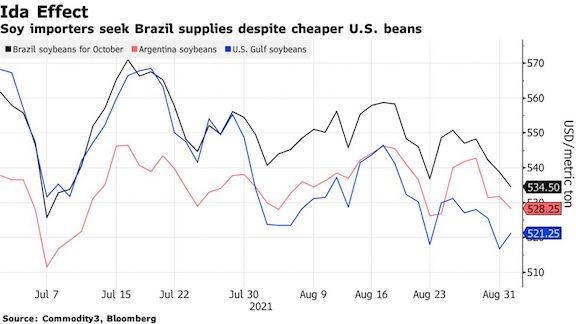Crop-trade routes altered as Ida aftermath disrupts US port
Hurricane Ida’s lingering impacts to the busiest U.S. agricultural port is showing early signs of altering crop-trading routes.
China soybean buyers began shifting orders to agricultural powerhouse Brazil for a shipment in October—during the U.S. harvest when American supplies are the biggest—after Ida damaged a key export terminal and left others without power.

“Buyers haven’t had many options to get soybeans after Ida,” said Eduardo Vanin, an analyst at brokerage Agrinvest Commodities, who’s aware of one confirmed cargo of Brazil’s costlier oilseeds. Vanin’s firm is getting more offers for Brazilian soybeans and while not sufficient to attract sellers yet, he said in an interview that they may rise if U.S. port issues linger.
The lower Mississippi river is by far the largest U.S. export region for soybeans and corn, accounting for more than half of U.S. shipments, according to the Soy Transportation Coalition. The shutdown of port facilities that are key to getting American exports overseas are forcing big buyers such as China to look elsewhere and adding to supply-chain snarls that have disrupted shipments for goods ranging from crops to computer chips.
With U.S. Gulf port terminals without power and a large facility operated by Cargill Inc. damaged, traders are expected to boost rail shipments to the Pacific Northwest to sail to Asian markets such as China. Still, outages caused by Ida threaten to hit demand for American supplies just as rainfall lifts yield prospects for corn and soybean fields. Together, rains in the U.S. Midwest and Ida storm damage have pressured crop futures in Chicago.
Meanwhile, Brazil is in its off-season with limited volumes of soybeans available and farmers who have been reluctant to sell at current prices, Vanin said. South American beans have traded at 35 cents to 40 cents per bushel higher than U.S. prices, Vanin said.
Similar Stories

Cuxport enhances operations with new terminal operating system from Kaleris
View Article
December 2024 U.S. Transportation Sector Unemployment (4.3%) Was the Same As the December 2023 Level (4.3%) And Above the Pre-Pandemic December 2019 Level (2.8%)
View ArticleDP World appoints Jason Haith as Vice President of Freight Forwarding for U.S. and Mexico
DP World, a global leader in logistics and supply chain solutions, has announced the appointment of Jason Haith as Vice President, Commercial Freight Forwarding – U.S. and Mexico, effective immediately.…
View Article
Amaero secures final approval for $23.5M loan from Export-Import Bank
View ArticleU.S. Bureau of Labor Statistics employment situation
Total nonfarm payroll employment increased by 256,000 in December, and the unemployment rate changed little at 4.1 percent, the U.S. Bureau of Labor Statistics reported today. Employment trended up in…
View Article
NAWE issues statement on Master Contract tentative deal
View ArticleGet the most up-to-date trending news!
SubscribeIndustry updates and weekly newsletter direct to your inbox!





